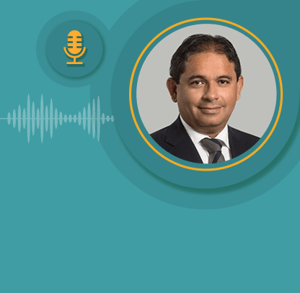In this podcast series, Deminor Litigation Funding interviews global professionals to share their perspectives on different aspects of dispute resolution and litigation funding.
Podcast Preface
In this interview, we speak with Benjamin Bathgate (BB), Partner at WeirFoulds in Toronto and leader of the firm's Commercial Litigation and Blockchain Groups. In conversation with Deminor's David Walker (DW), Benjamin discusses his work in digital asset recovery, including obtaining Canada's first Anton Piller order for crypto seizure, the unique challenges of blockchain-based fraud cases, and the critical role that litigation funding could play in this rapidly evolving space.
Podcast Transcript
DW – Hello everyone, and welcome back. We're joined here today by Benjamin Bathgate, who's a partner at Weir Foulds in Toronto, dealing principally with digital assets and asset recovery.
Ben, tell us a bit about your background, about you and what you do?
BB – Thanks, David. I appreciate you having me on.
As you said, I lead the Commercial Litigation Group and the Blockchain Group at my firm, WeirFoulds, and we're a leading regional firm in Canada. I've been practising for around 20 years now, primarily in fraud and recovery cases. For the vast majority of that time, I dealt with conventional assets, sharpening my teeth on some of the big fraud cases in the securities space and strict commercial recoveries as well.
Then, I'd say around five years ago, I had a big shift in my practice (which has really taken hold and become my speciality). I handled the first case involving an Anton Piller order on digital assets in Canada. For context, a civil search and seizure order you can obtain from a Canadian court over property and assets.
In this particular case, we were granted permission to seize digital assets as property. Specifically, in this case we could seize what is known as a cold storage digital wallet. That's essentially a hardware device secured by a personal passcode. We obtained the first court order to seize such a wallet as part of a proceeding. This involved seizing the phone of the alleged “bad actor” and obligating them to provide the passcode; failing which, they would be held in contempt of court. When we obtained that first-of-its-kind order in Canada (five years ago now), that really changed our practice. Ever since, it's been around 80% of what we do.
These digital asset cases are still fraud and recovery cases, as they've always been for us. But now, 80% of the time, they involve digital assets. Frankly, we love the hunt. That's part of it for us. Many of our cases (even indirectly) intersect with digital assets. They're just part of portfolios and investments these days. They're not as niche as they used to be, necessarily. The reality is, investigations and recovery work are very different when digital assets are involved, whether it's a fraud or just some other commercial dispute where digital assets form part of the portfolio.
We often consult with fraud recovery, commercial, and corporate lawyers who don't have experience with digital assets. We teach them how things are different, and how you really need a different team and a different investigative approach when digital assets are involved. That's really our focus now. It's what gets us excited. And I certainly appreciate you bringing us on to talk to your audience about it.
DW – Thanks, Ben.
Obviously, as you said, you've worked across asset recovery generally and also in commercial litigation. But now you have this focus on digital assets and those disputes. A lot of people get quite nervous about digital assets generally, as something suspicious or even something completely incomprehensible.
Do you see that changing in any way? And do you see an increase generally in engagement with digital assets that's not always suspicious?
BB – Yeah, it's funny because we do get asked that a lot, as we now really hold ourselves out as digital asset recovery lawyers.
A lot of people get quite nervous about digital assets generally as something suspicious or even something completely incomprehensible. "How can you work in the blockchain space and digital asset recovery? How do you wrap your head around such a terrible, intangible asset class? There's so much risk, so many bad actors, and so much shadiness. How do you do that?"
My response is, "Well, I'm a fraud and asset recovery lawyer. So, in this day and age, what choice do I have?"
I often turn it around and ask fraud and recovery lawyers: "How do you not work in this space? How do you not understand this asset class?"
It's certainly changing. There is no question about it. It's not as niche as it used to be. We're seeing it as very much a part of everyday investment portfolios. Investors (big and small) are getting into this space more and more, increasingly every year. There are many more cases. And, regrettably, there are many more opportunities where fraud arises, because it is a medium that does attract bad actors. There's a lot of anonymity, obviously, and the perception of less accountability. Although, I would certainly contest that.
However, people are starting to see how these cases are very different and have a very special aspect to them. Really, our job is to keep it simple. What we try to do is draw the analogies, showing how digital asset cases are really not unlike other fraud and recovery cases, at least in terms of the instruments and tools we bring to bear.
In fact, coming up this year, we're teaching here in Canada about digital assets and about how the investigation is different. For instance, what questions do the judges have to ask? That's certainly part of the system: the court system, maintaining accountability and going to the next level as these frauds persist. However, when you look at the fraud cases, and how a crypto case distinguishes itself from a non-crypto case, there's a certain beauty to it. It's interesting, and it is different. If I think back to all the fraud cases involving conventional assets, how often do I have the books and records I need? How often is the transaction data I need openly public and online? That's the beauty of the blockchain. It's a public ledger and it's available. However, there is certainly some obscurity with respect to the identities of certain accounts, and there are mixers and other tools that can sometimes obfuscate certain transactions. So, you need to have the right team members, who we bring in right away.
You need to move quickly. Sometimes, cases don't work. But if you move fast, have the right team, and (frankly) you get a bit of luck on your side, sometimes a bad actor makes a mistake. Maybe they get too confident, or don't have good operational security.
Certainly, is the medium often used (or can it be used) in illicit ways? Sure, it can. And that's unfortunate. But that's where we come in. And with the right team, recovery for plaintiffs is very much possible. It just has to be evaluated very quickly.
DW – And you mentioned giving training to the judiciary in Canada.
Do you think the courts in Canada are now becoming more accustomed to digital assets and disputes relating to them?
BB – I see that improving every week. I think we owe some thanks to the UK courts and all the "persons unknown" cases, which we've followed with a lot of interest.
I think the Canadian, and frankly, the U.S. courts, are catching up in that regard.
I do think it's important for judges to understand what digital assets consist of, the questions they have to ask, where they need to probe, and what expert evidence they really need, whether that's blockchain investigation or otherwise. We certainly see improvements there.
However, part of the reason we designed this programme for the Canadian Institute for the Administration of Justice (CIAJ) is to help educate our judiciary, as well as members of the Justice Department, the government, and lawyers, about digital assets. The goal is really to help demystify it. Because on certain levels, it's not that you need to understand the difference between Solana or Ethereum or things like that. You mainly need to see how these assets are not unlike asset classes already familiar to the judiciary. What you really need is the right evidence and expert input, so the judiciary can ask the right questions, get the right answers, and do what they do best: connecting the dots and applying legal instruments that, from days gone by, have always worked to freeze, seize, and obtain third-party data. The truth is that those instruments still work. I think judges, generally, have done that application correctly.
We just want to help, through designing this education programme, in going to that next level: explaining why that forensic blockchain investigator we bring in can help, and how they can identify, through their research and tools, the identities behind accounts. And through that probabilistic analysis, they can provide as much certainty as possible to the process. Then, just like with any other expert report, the judge has to balance that, and consider whether you can cross that threshold or not. We do see progress there; but obviously, there's a lot of work still to be done.
DW – In this new generation of cases and disputes over digital assets, do you see any major trends emerging at the minute?

BB – Yeah, absolutely.
Certainly, in terms of the types of frauds, we're seeing some new ones, but we're also seeing the classic ones: reworked, redone, and on a bigger scale. Your classic investment schemes, for example (Ponzi schemes), we've seen a lot of those, and they're growing in size.
You see a lot of the newest tokens being offered, or new forms of decentralised finance platforms, where people can trade, loan, and do these kinds of financial processes, but on a decentralised platform. It's an exciting concept that's been around for years now, and there are tens of billions on these platforms.
However, you keep seeing the new big platform, the new token. It may be hard to believe, given how often these crop up, but it still works. People are still investing in them, even without proper white papers, or documentation describing ownership structures and the fundamental underpinnings these projects should have. When you have more retail investors entering the space, obviously you see more and more frauds succeeding, so they're going to keep getting reproduced.
Chainalysis, which is one of the big investigative and enforcement blockchain analytics groups out there, has often supported law enforcement and prosecutions through expert evidence, for example, in the courts. They've identified, as they've looked at the trends, increasing amounts of crypto and digital assets being moved to illicit addresses: from $11 billion being moved in 2020, to an estimated $51 billion last year. Then you have to think about all the unreported movement as well, where people just don't bother to report, or don't think there's any point.
Taking that into consideration (and all the addresses that haven't even been identified as illicit), you're obviously looking at many tens of billions in illicit movement of funds. And this, of course, brings up other questions and trends: increased concerns around money laundering, criminal enterprise funding, and the financing of very serious crimes through crypto as a medium.
There's an array of illicit actors in transnational organised crime that is really increasing and using this to its fullest extent. Really, you have crypto funding these "poly crimes": these multiple crime types. That is obviously a concern in itself.
We'll have to wait and see what happens, and I think we're all watching with interest what unfolds in the U.S., especially with the new White House administration; the Enforcement Task Force being disbanded, but new groups being formed. Are they going to be able to enquire? Are they going to continue to investigate crypto as a medium for illicit funding of crimes (serious crimes)? What is going to be done? What investigative work will still happen to address that?
And I think the other big trend (we've always seen this, but I think it's just becoming more and more important) is this push and pull, this tug of war over the battle for information. When you see your crypto leave, when you see it move on the ledger to other accounts, it all comes down to the question of whether you can get at that information. Through the right programme, with the right blockchain forensic investigator, can you identify something about those other accounts? You can see the account number, but who's behind it? Is this another exchange, an intermediary, where you might be able to flag it on the protocol and actually get it seized in the future, potentially through a court order? Or is it just a wallet held by someone in a jurisdiction you can reach, or perhaps in one you can't?
This tug of war over what we call "Know Your Client" information, over what is considered the private data of account holders (data held by wallet service providers, exchanges), that battle is only becoming more and more important. And you always see the push and pull of privacy versus accountability, and the needs of the courts to access information when a court order requires it. That's so important, because at the end of the day, the opportunities for plaintiffs on the recovery side really come down to getting behind those accounts. The ability to do that, and not allow obfuscation of those transactions to win the day, that really helps determine how realistic recovery chances are. A lot of cases won't work out. But our ability to get at that KYC data and access that core information really helps create the world of the possible when it comes to recovery.
DW – And as a funder, when we're looking at any dispute, we're always interested in the proceeds at the end of the day and the likelihood of getting at them. Sometimes, people have a perception that if there's a dispute (fraud, or whatever kind of dispute involving digital assets) that there's very little chance of ever recovering those assets.
Is that perception accurate? And how do you deal with it?

BB – Yeah, that's a great question, David.
And like all lawyers often do, I'll give you a conditional, somewhat unhelpful answer, because the answer is really yes and no.
I'd say in 90 to 95% of the cases, both big and small, that come to me (and I get half a dozen to a dozen inquiries every day), it's really unfortunate, and sad, frankly, the number of people reaching out. These are small investors, big portfolio holders: all shapes and sizes. We get those inquiries every day, because this is virtually all we do in Canada. And in 90 to 95% of them, frankly, they just don't work out.
We'll know that when we go through a checklist of five or six questions. At a very high level, we'll know pretty quickly whether a case is likely to succeed. Because the bottom line is: Yes, you've got the public ledger, and there's a lot of potential for tracing. But you need to ask a few fundamental questions:
What data is known about the transaction? What can you obtain through a blockchain forensic investigator? Often, there has already been a report prepared, maybe by a token recovery firm, so what do you know about the accounts involved?
Usually, within a few questions, you'll know whether this is locked up somewhere on a protocol. You will want to know if it is with an exchange or an intermediary, where you can potentially get at it with a court order, depending on whether they're legitimate and where they're located. Or is it one where it's gone cold. It may have been moved to a wallet or phone and that is something you can only access via a passcode from an individual. If that's where it is, then the next question becomes whether we can find out where they are, or not. With a few fundamental questions like that, you're going to realise pretty quickly if it's one of those 5% of cases that are viable, or not.
From both a funder's and a plaintiff's perspective it is fair to ask if that is realistic? How often does it work? The truth is: most times, it doesn't. We're always up front about that. It's really part of our policy to always have that first call, even with the small cases, just to see if there's anything that's possible. But the other side of it is that while there's a lot of truth to the idea that many cases won't be recoverable, there are always exceptions to that rule.
We do see some bad actors who are overconfident, and you can trace back. And we've seen it happen, where they end up getting doxxed. Their identity gets exposed online (often by some very angry people who lost their investments in crypto) and you find out who it is. Sometimes, they're in jurisdictions where you can get at them. And we've got court orders to that effect: to seize their wallet and go after them.
If they don't comply and transfer it to a custodian (an interim custodian ordered by the court), they'll be held in contempt of court, and they can go to jail. There are measures to do that.
However, the fundamental question becomes whether you can get at that natural person behind a cold storage wallet. Or, can you access a protocol where some of the funds were locked up, because somebody realised what was happening quickly enough to freeze it before it was moved cold?
Frankly, we have seen (and been involved in) cases in the tens and hundreds of millions. I mean, there are some really big cases that involve frauds, conspiracies, insolvencies with bad debt, where hundreds of millions, even over a billion, have been locked into protocols. In those cases, there is certainly a recovery pathway.
So much of this depends on the case itself, and that due diligence is going to be a fundamental part of it. But is it possible?
Certainly, in some cases, it is. And if it is possible, if it's locked up in the protocol, or you know who has control of the wallet and you can get at them, then you've got 90% or more of the evidence you need online and public.
That's not often the case in the old conventional asset world, and so there is that benefit.
DW – Finally, on that point, what role do you see potentially for funding in relation to these kinds of disputes over digital assets?

BB – I think there's great possibility, great opportunity, but it's really underdeveloped, I would say.
There are some very large funders that are perhaps a bit more bureaucratic, and it can be a challenge sometimes convincing them: on the subject matter, on the opportunities that exist, and on how these cases can be investigated and traced with a high degree of certainty, if you've got the right programme and the right blockchain forensic investigator on your team.
There's great potential there. But I think it's really about finding funders who understand the space. Because they have to understand it. If they don't, people like me explaining it isn't going to go very far. When you see tens of billions moving to illicit addresses, and many fraud cases dying on the vine (because you've got a large, disparate group of people who lost money and gave up), it's a missed opportunity.
I've seen some of these loss holders get very creative. They've created their own liquidity pools, where they'll invest as a group, almost like a cooperative. They'll invest, they'll trade, and they'll work as an online cooperative. We call them pools; they fund into pools, but they're decentralised, essentially, just groups of people organising on their own. Sometimes they'll create these pools, not just for investment purposes, but to fund their own litigation. Each person might contribute a portion into a pool to finance the legal effort. However, that's a hard sell, especially to people who've already lost a lot. It requires a fair bit of organisation and cohesion, which can often be a challenge.
That's a whole different topic with regard to these decentralised autonomous organisations (DAOs) and how they're run. Simply put, it's difficult. However, that creates an opportunity for funders, because many law firms don't have the scale or sufficient resources to fund a lot of the upfront work themselves.
Some might do it on a contingent basis, but often those are class actions, which can be very administratively difficult to move forward in an efficient way.
So I do see great opportunity for funders who can be nimble, and who understand the subject matter. At the end of the day, what does a funder need? Well, they need that front-end investigation and that forensic analysis to really determine:
- Did these funds get moved somewhere we can get at them? Are they locked on a protocol?
- Did it go cold, but to a person we can actually get at?
That front-end investigation is often what my team and I do as soon as we match up with a blockchain forensic investigator. We determine that very quickly.
We'll often do that investigative work right up front, and we do it quickly and efficiently. We can then take a package of reports to a funder and say:
"Look, we've already got this claim drafted out. The fraud in it is relatively straightforward. Here's the expert analysis. Let's take this to the next level."
If that funder is nimble and open to the subject matter, if they understand it on some fundamental level, we can bring these pitches forward, based on that front-end investigative work.
And really, the public ledger can “set you free” there. It can fill in those blanks and move a funder and the plaintiff group light years further than they would be if they were chasing private records from some massive company that didn't want to give them up.
There's a lot of opportunity there. And we're hoping that more funders will see that and move into the space, because we're seeing a lot of big plaintiff cases die on the vine, simply because there isn't enough front-end funding to move them to the next stage. Let's do that blockchain forensic analysis, and let's see what's possible.
Podcast Speakers and Further Information:
Thanks for joining Deminor's Litigation Funding Podcast Series as we dive deep into core topics in funding litigation.
Keep a lookout for our upcoming conversations as the Deminor team speaks with several more experts to get their insights into different aspects of litigation funding.
If you would like to connect with either Benjamin or David on LinkedIn, please click on the links below:
Benjamin Bathgate, Partner at Weir Foulds –
https://www.linkedin.com/in/benjamin-bathgate-19863a54/
David Walker, General Counsel (UK) at Deminor – https://www.linkedin.com/in/dc-walker/
***
Click below to view more interviews from Deminor's Litigation Funding Podcast Series:








